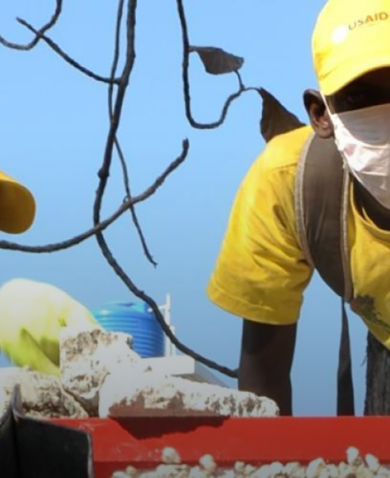
Chemonics News
News: Chemonics’ E-Payment Activities in Afghanistan
September 25, 2017 | 3 Minute ReadChemonics debunks myths and shows progress implementing an e-payment system to improve the business climate in Afghanistan.
After decades of war, Afghanistan continues to raise headlines questioning the effectiveness and value of providing development assistance in such a conflict-prone country. It is easy to focus on the negative headlines and criticisms. Yet while there are challenges, there are also successes that prove why these investments matter. The Afghanistan Trade and Revenue (ATAR) project is one of those complicated yet significant successes.
In late August, the Special Inspector General for Afghanistan Reconstruction (SIGAR) published a report on the ATAR project, which Chemonics is implementing on behalf of USAID/Afghanistan, criticizing portions of the project’s work and the investments associated with it. In response to the report, several media articles published stories about ATAR’s work on e-payments that misrepresent the project’s efforts to improve the business climate in Afghanistan.
ATAR collaborates with the public and private sectors to improve Afghanistan’s business climate to enable private investment, create jobs, and enhance trade and fiscal sustainability. One element of the project’s many technical assistance areas is to implement an e-payment system in the country to modernize and improve the way in which customs-related duties are collected on behalf of the Ministry of Finance, and to bring more efficiency and transparency in revenue collections made from customs duties. While the project has encountered some obstacles, ATAR has also achieved significant results on e-payment, and on the ATAR project in general.
Debunking the Myths and Demonstrating Progress
Below are the facts behind some misconceptions about ATAR’s e-payment program:
- USAID spent $160 million on an e-payment program in Afghanistan. Chemonics has implemented two consecutive USAID programs — the Trade and Accession Facilitation for Afghanistan (TAFA) project and the ATAR project — that in total have amounted to approximately $160 million. E-payment activities only accounted for an estimated 0.7 percent of ATAR’s total $77.8 million budget; the objectives of the project are much broader than e-payment alone. ATAR is collaborating with public and private sector actors to promote trade through three critical areas: 1) trade policy liberalization through Afghanistan’s accession to the World Trade Organization; 2) regional trade integration in South and Central Asia, as well as expansion into international markets; and 3) various customs reform activities aiming to bring Afghanistan in line with international standards. E-payment activities fall under this third component.
- USAID’s e-payment activities are not effective. SIGAR’s report cites that the ATAR program has not been able to achieve its ambitious target to reach 75 percent of revenue collection through e-payments. While true due to a number of critical obstacles, the project has still achieved tangible results. Under ATAR, the e-payment system was rolled out to 90 percent of collection locations around Afghanistan. This work was conducted with only a small fraction of ATAR’s overall project resources, and set the foundation for what now appears to be a resurgence of interest by the government of Afghanistan to directly lead the adoption and expansion of e-payment in Afghanistan.
With ATAR’s support, Afghanistan government counterparts have developed significant measures over the past six months to resolve key obstacles hindering e-payment adoption to date. For example, a key constraint to e-pay adoption was that Afghans could still use cash for transactions. To address this, the Central Bank of Afghanistan has now noted it will stop collecting cash for customs duties, which should significantly encourage traders to use the e-payment system. Lagging transaction times for e-payment was another deterrent to using the system. However, the Afghan Customs Department now recognizes the need to improve the linkages between commercial banks and the Central Bank of Afghanistan to speed the e-payment system to make it more attractive as a payment method.
According to the Afghanistan Customs Department, records already show an increase in e-payment transactions over the past several months, as well as increases in customs revenue compared to this time last year. This, along with recent interest of new federal partners in using the e-payment system, demonstrate the continued long-term potential for this approach.
Achievements in Afghanistan
Over the past five years, USAID’s TAFA and ATAR projects have achieved a great deal in partnership with Afghanistan government entities, individuals, communities, civil society groups, and private sector actors. For example, the projects have:
- Supported Afghanistan in becoming a full World Trade Organization member in July 2016, following years of complex work in trade reforms and trade negotiations by the Afghan government, with the assistance of TAFA and ATAR
- Helped Afghanistan ratify the World Trade Organization’s Trade Facilitation Agreement and pass more than 20 complex trade-related laws that serve the foundation of any modern, vibrant trading regime and cover areas like trade policy, customs, food safety, animal and plant health, and intellectual property
- Supported the participation of hundreds of Afghan exporters in 15 high-level international tradeshows, where they signed more than $30 million in deals
- Facilitated business growth by helping the Afghan government issue a single business license in place of the multiple investment and trade licenses that had been required of companies
- Facilitated negotiations on trade and transit agreements with regional trading partners, such as the South Asia Free Trade Agreement, which helped Afghanistan to dramatically increase its exports to India










































